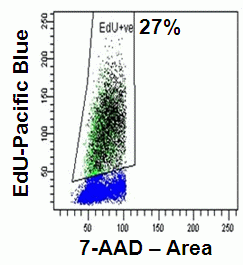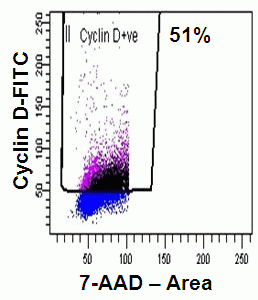S-phase analysis using 5-ethynyl-2 deoxyuridine (EdU) uptake
EdU like BrdU is a nucleoside analogue to thymidine which is actively transported into cells while dividing and is incorporated into the newly synthesized DNA structure. The use of antibodies with a fluorescent tag against BrdU makes it possible to determine S phase if cells were pulsed with 10uM BrdU more accurately then just using DNA binding dyes such as PI, 7-AAD, DAPI or ToPro-3. However the method by a practiced technician takes 2 hours and requires the harsh treatment of cells with 2M hydrochloric acid. Thus making it difficult to detect surface and other intracellular antigens when using the standard BrdU protocol.
When using EdU (10 uM) to determine S phase the labelling procedure takes 45 minutes. This involves an aldehyde fixation step for 15 mins. After which a permeabilisation step for antibody labelling of surface or intracellular antigens can be done. After which the EdU is then labelled by click chemistry involving a copper catalyzed covalent reaction between the alkyne part of EdU and the fluorescent azide reagent supplied. The azide reagent is small and hence gains access to the cell easily and a range of fluorescent tags can be attached to the azide group including Alexa Fluor 488, 647 and Pacific Blue.
Here we describe how the standard EdU assay using azide labelled with Pacific Blue and DNA labelled with 7-AAD can be used also to detect the intracellular antigen cyclin D.


